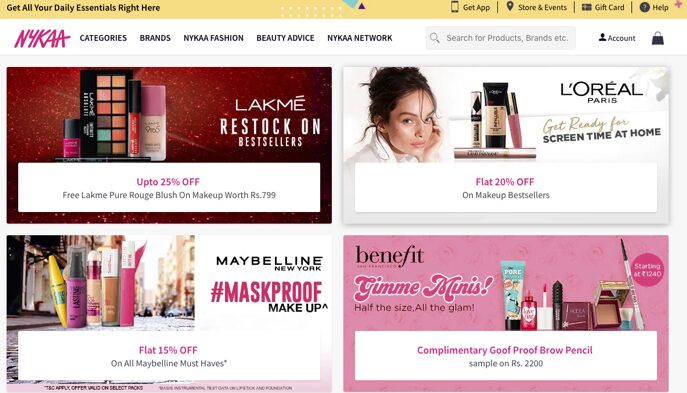Data & Creativity – Can The Twain Meet?

Discover how brands like Titan, Amul, Nykaa, and Gap show why blending insight with imagination drives lasting success.
Walk into a mall or scroll endlessly through your favourite e-commerce app, and you’ll notice something curious. Some brands feel timeless, like old companions you trust. Others show up with noise and novelty but vanish just as quickly as they arrive.
Why? The difference is rarely about resources alone. More often, it’s about how well leaders blend data with creativity. Data, after all, can illuminate what has been. Creativity, meanwhile, imagines what could be. Together, they can propel a brand forward. Apart, they can drag it down paths of irrelevance.
“Data shows the past; creativity imagines the future.”
The Gap in Gap: When Numbers Overwhelm Imagination
The story of Gap is a textbook lesson in imbalance. Founded in 1969, Gap was an instant hit, built on a straightforward promise: Levi’s in every size, always available. By the 1980s, it had become an icon of casual American style.
But fashion is fickle, and by the late 2000s, Gap was faltering. Successive CEOs attempted to revitalise the brand by focusing on metrics—inventory optimisation, pricing adjustments, and operational efficiencies. Useful, yes, but soulless. Gap’s real issue wasn’t logistics. It was style, imagination, and relevance.

The problem wasn’t that they lacked data. It was that they mistook data for direction. Spreadsheets could tell them what was selling yesterday, but not what would excite tomorrow’s consumer.
Now, with Richard Dickson—a creative-minded leader—at the helm, Gap is trying to restore balance. The lesson? In industries where imagination defines value, relying solely on numbers is like trying to paint by statistics.
“Numbers explain yesterday. They don’t create tomorrow.”
The Other Extreme: When Creativity Outpaces Reality
If too much data suffocates imagination, unchecked creativity can just as quickly wreck brands. Take J.C. Penney. When Apple retail veteran Ron Johnson took charge in 2011, he aimed to reinvent the department store experience—eliminating discounts, adopting modern layouts, and incorporating stylish branding.
The ideas were bold. The problem? They weren’t grounded in the reality of Penney’s existing customers, who loved discounts and affordability. Johnson’s vision wasn’t tested, refined, or informed. Within two years, the strategy collapsed into a retail debacle.
This is the other danger: creativity without discipline. Without data and insight to anchor it, creativity can become indulgence—beautiful, but irrelevant.

The Middle Path: Synthesis Over Analysis
So what’s the sweet spot? It’s not analysis versus imagination. It’s synthesis.
Data provides patterns. Creativity interprets those patterns. Together, they create insights that can change the trajectory of a brand.
Consider Abercrombie & Fitch. Once the ultimate “cool-kid” brand, its logo-heavy, exclusive marketing alienated consumers over time. When new leadership arrived, they didn’t just stare at the falling sales charts. They asked, ‘What do consumers aspire to now?‘
The answer: tasteful, versatile clothing for young adults entering new life stages—workplaces, weddings, and social gatherings. The brand pivoted creatively, guided by data but not chained to it. Sales rebounded, and Abercrombie became relevant again.
“Synthesis turns patterns into possibilities.”
Lessons From India: Data Meets Culture
Indian brands offer some of the most powerful stories of this synthesis.
Titan: Watches as Cultural Symbols
When Titan entered the watch market in the 1980s, it faced a choice. Should it emulate Swiss luxury or produce affordable timepieces? Instead, Titan studied Indian consumers and uncovered a deeper truth: a watch is more than a timekeeper—it is a gift, a symbol of success, and a fashion statement.
This insight, combined with data on affordability and usage, led to a multi-brand strategy: Sonata for value, Raga for women, and Fastrack for youth. Each brand spoke to different aspirations, and together they reshaped India’s watch culture.

Amul: Wit Meets Discipline
Amul, India’s beloved dairy cooperative, runs on both rigour and imagination. Data drives its supply chain and pricing decisions, but its true genius lies in creative communication. For decades, the Amul Butter Girl has cheekily commented on politics, cricket, Bollywood, and social events.
These ads aren’t born from algorithms alone—they come from cultural listening, wit, and human imagination. Amul proves that numbers can guide business, but creativity makes it loveable.
Nykaa: Beauty, Reimagined
Nykaa, India’s digital beauty giant, is a master of informed leaps. Founder Falguni Nayar mined e-commerce data to understand what Indians were searching for and buying. But she didn’t stop there. She reimagined how Indians discover beauty: through influencers, experiential stores, and private-label brands tailored for Indian skin tones and preferences.

Nykaa’s expansion into men’s grooming, luxury categories, and regional beauty wasn’t a gamble. It was creativity backed by insight—an informed leap into unmet demand.
“Culture gives data a direction.”
From Information to True Insight
One of the biggest mistakes brands make is treating information, trends, and insights as the same. They’re not.
- Information is raw: sales figures, click-through rates, demographics.
- Trends are patterns, such as the rise of clean beauty, the popularity of digital wallets, or the demand for sustainable packaging.
- Insights dig deeper. They explain why trends matter and how they can change behaviour.
A genuine insight surprises you—and compels action. Titan realised young professionals buy watches primarily as gifts, not just for themselves. That single realisation reshaped campaigns and packaging. Amul saw butter as a conversation starter, not just a food product, leading to decades of witty ads.
Data can provide clarity, but only insights, fused with imagination, create breakthroughs.
“Insight surprises; information reports.”
Why Leaders Fear the Leap
In today’s high-stakes corporate world, leaders often cling to data as a shield. Numbers feel safe, measurable, and defensible. If something fails, they can say, “The data made me do it.”
But authentic brand leadership requires courage: the courage to take informed leaps of faith. Not reckless gambles, but steps guided by research, cultural cues, and creative vision.
The best leaders know that measurement can evaluate but not create. Imagination can inspire, but it needs to be grounded in reality. And that great brands are built not by avoiding failure but by learning from it.
“Pilot boldly, scale wisely.”
Rules of Thumb for Leaders
- Ask “why” before “what”. Numbers show results, but leaders must dig deeper to find the causes.
- Balance analysis with synthesis. Don’t just dissect data—connect dots across culture, behaviour, and aspiration.
- Run pilots. Test creative ideas on a small scale, refine them, and then scale.
- Protect creativity. Don’t let metrics crush imagination before it breathes.
- Make insights shareable and straightforward. If your team can’t act on them, they’re not insights.
The Final Reflection
Managing a brand portfolio or leading a single iconic brand is not about choosing between discipline and passion; it’s about striking a balance between them. It’s about weaving them together.
Not all data leads to good creativity. Some data seduces us into incrementalism, into “safe” moves that never surprise or delight. Some creativity misleads us into vanity projects disconnected from reality.
The real craft lies in informed imagination—where data illuminates tensions and opportunities, and creativity transforms them into powerful stories and experiences.
When data and creativity come together, brands don’t just follow the market; they shape it. That’s how Titan redefined time, Amul turned butter into a cultural icon, Nykaa transformed the beauty retail industry, and Abercrombie found a second life.
“Use data to ask bold questions. Use creativity to answer them.”
Ultimately, brands are not remembered for their quarterly reports. They’re remembered for the way they surprised us, delighted us, and wove themselves into the fabric of our lives.



